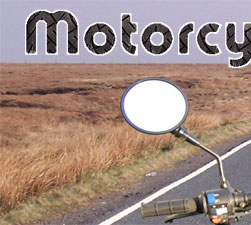|

|
Motorcycles can require a good deal of maintenance to perform at their peak. Your first resource for important motorcycle care information is your motorcycle owner's manual. Before getting on your new bike, it is important to read through your owner's manual since there is usually a break in procedure that needs to be followed. Though different bikes require different upkeep, here is a list of common services for keeping your motorcycle running strong and avoiding costly repairs.

- Spark Plug Replacement - Motorcycle spark plugs
 need to be replaced more frequently than their car counterparts.
Spark plugs
need to be replaced more frequently than their car counterparts.
Spark plugs on your bike should usually be swapped out by 10,000 miles on your bike should usually be swapped out by 10,000 miles
- Carburetor Adjustments - Usually the carburetor should
be checked and adjusted if necessary at the same time
spark plug maintenance is done. Periodically, a fuel
injector/carburetor gas additive
can be mixed with fuel. Make sure to review the instructions
closely since a bottle is usually measured out for much
larger car gas tanks so you may not need the whole bottle.
- Fuel Filter/Petcock Maintenance - Motorcycle fuel filters should be replaced from time to time. Many bikes do not have true fuel filters. In this instance, the gas tank's petcock should be removed and its internal screen cleaned.
- Coolant - The coolant level on water-cooled motorcycles should be checked frequently. Check your owner's manual to see when the coolant should be flushed and filled.
- Chains, belts, and drive shafts - The life expectancy of
a motorcycle chain is usually between 15,000 and 25,000
miles. To get the most out of your chain it is important
to make sure it is properly tensioned and lubricated.
The chain should be cleaned before lubricating, either
with kerosene or chain cleaning product. If your chain
is constructed with O-rings, make sure whatever solvent
used is O-ring safe. The motorcycle's sprockets should
be cleaned at this time as well. You can purchase spray
on products designed for motorcycle chain lubrication or use heavyweight oil. Motorcycles with
belt drives end to require less maintenance than chains.
Belts will also last longer as long as the rear sprocket
is kept free from stones and debris. Inspect the belt
after riding on gravel or dirt to prevent damage. If your
motorcycle is drive shaft powered, the most important
maintenance service is changing the oil in the gear housing.
- Transmission - The transmission on most motorcycles is integrated with the engine and does not require special maintenance. Harley-Davidson engines have a separate transmission that is connected by to the engine by the primary chain. Every 10,000 miles the tension on the primary should be checked and adjusted if necessary. The oil in the primary and transmission should be changed at this time as well.
- Cables - A motorcycle's clutch and throttle are operated
by cables, which can bind if not properly lubricated.
A motorcycle cable lubricator is an inexpensive tool that slips over the cable's sheath
and directs spray lubricant along the cable. The clutch
cable can also stretch over time and lever play should
be checked at every oil change. The tension can be adjusted
turning a bolt along the cable near the left hand grip.
Check your owner's manual for proper specs and tensioning
procedures.
- Tires - It is important to check the motorcycle's
tire pressure
 and tread on a regular basis. A motorcycle only has two tires to transfer all breaking, acceleration and handling forces to the pavement and if the air pressure is not correct or the tread worn, performance will suffer. The life expectancy of a motorcycle's tires is much less than the average car tire. You can purchase pressure monitors that attach to the rim and transmit pressure and temperature data to an LCD display that can be mounted on the gauge cluster. This allows the motorcycle rider to constantly observe the air pressure which helps touring riders avoid overloading the bike or tires and aggressive riders can calibrate their tires to ride at optimum pressure and temperature. One leading manufacturer of these inflation gauges is SmarTire Systems, Inc. The correct tire pressure can be found in the motorcycle owner's manual (and usually under the bike's seat).
and tread on a regular basis. A motorcycle only has two tires to transfer all breaking, acceleration and handling forces to the pavement and if the air pressure is not correct or the tread worn, performance will suffer. The life expectancy of a motorcycle's tires is much less than the average car tire. You can purchase pressure monitors that attach to the rim and transmit pressure and temperature data to an LCD display that can be mounted on the gauge cluster. This allows the motorcycle rider to constantly observe the air pressure which helps touring riders avoid overloading the bike or tires and aggressive riders can calibrate their tires to ride at optimum pressure and temperature. One leading manufacturer of these inflation gauges is SmarTire Systems, Inc. The correct tire pressure can be found in the motorcycle owner's manual (and usually under the bike's seat).
- Alignment - When a motorcycle's tires are replaced
or the chain tension adjusted, the alignment must be checked.
- Wheels - Though more motorcycles are offering alloy wheels, traditionally the wheels on a bike have been spoked. If a motorcycle has laced wheels, it is necessary to tighten the spokes from time to time to keep the rim from warping. Most motorcycle wheel bearings are sealed and do not require lubrication but some types much be cleaned and repacked with grease on a yearly basis.
- Suspension - A motorcycle's front forks are filled with oil that needs to be changed from time to time (some sources suggest yearly - many riders feel this is excessive). If the load the bike is carrying changes drastically, the level of compression on the rear spring should be adjusted. The motorcycle's swing arm should be should be greased yearly (some have fittings that allow the use of a grease gun - other must be disassembled). The motorcycle's down tube has upper and lower bearings that should be checked regularly. If these bearing are loose, the front fork will be loose and the bike difficult to control.
- Brakes - Motorcycle brakes
should be checked before each ride as brake failure can
have obviously catastrophic results. On disc brakes, it
is usually fairly easy to inspect the brake pads. Most
are self-adjusting and do not require much maintenance
aside from replacing them when worn. Brake fluid should
be checked at the upper reservoir before every ride as
well (usually through a glass window). Some experts suggest
having the fluid changed on a yearly basis but when speaking
with a mechanic he seemed confused about why I would want
to change my brake fluid, implying it wasn't necessary.
- General Lubrication - Basically, all moving parts should be lubricated on a regular basis. This includes the pivot point for the gear shift lever, brake lever, and foot pegs,
- Batteries - Unless your motorcycle has a maintenance-free
motorcycle
battery
 ,
it is important to check the electrolyte level at every
oil change and top off the battery with distilled water
if necessary. A turkey baster is a good tool for adding
water through the small openings in the battery. The battery's
contacts should be cleaned on a regular basis to remove
oxidation. Buildup of oxidation can interfere with the
transfer of electricity from the battery to the starter,
even if the bike's battery has a good charge. The contacts
on the motorcycle's cables should also be cleaned at this
time. A brass brush is good for cleaning the cables and
posts. ,
it is important to check the electrolyte level at every
oil change and top off the battery with distilled water
if necessary. A turkey baster is a good tool for adding
water through the small openings in the battery. The battery's
contacts should be cleaned on a regular basis to remove
oxidation. Buildup of oxidation can interfere with the
transfer of electricity from the battery to the starter,
even if the bike's battery has a good charge. The contacts
on the motorcycle's cables should also be cleaned at this
time. A brass brush is good for cleaning the cables and
posts.
- Oil - A motorcycle's oil
 and oil filter and oil filter should be changed according to the specifications in the motorcycle owner's manual. 5000-mile intervals are fairly standard. The weight of oil used depends on the motorcycle and the riding conditions. should be changed according to the specifications in the motorcycle owner's manual. 5000-mile intervals are fairly standard. The weight of oil used depends on the motorcycle and the riding conditions.
If you live in an area with a severe winter, it will certainly be necessary to store your bike for the winter. Many people have different opinions on how to properly prepare a motorcycle for winter storage.
Learn More About Winterization Techniques
|






